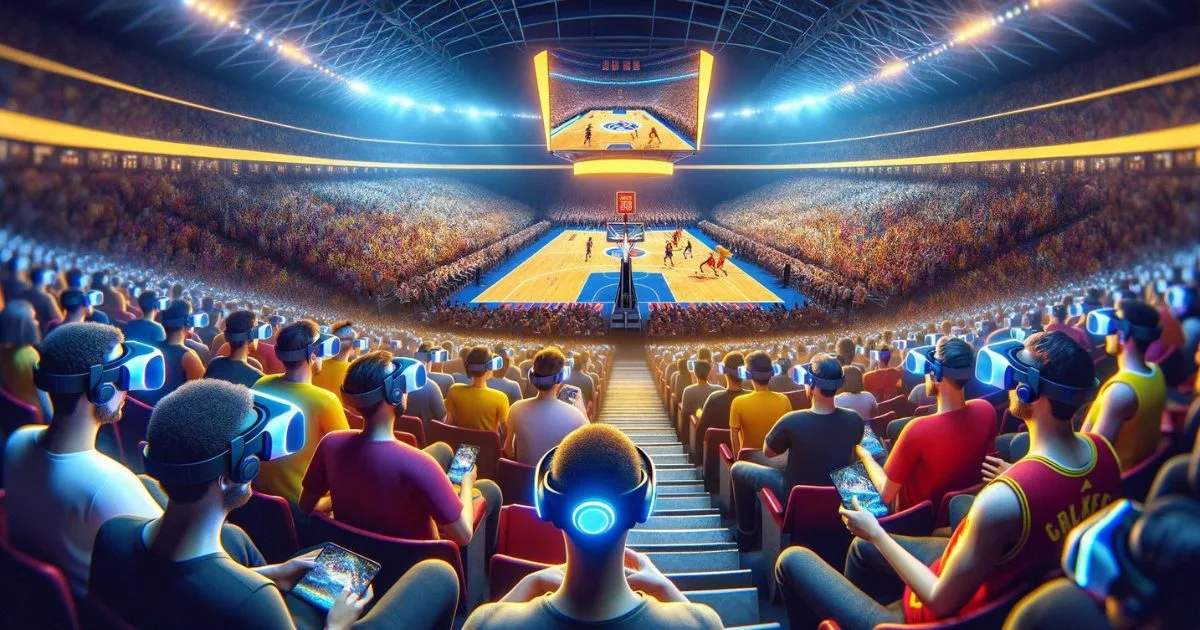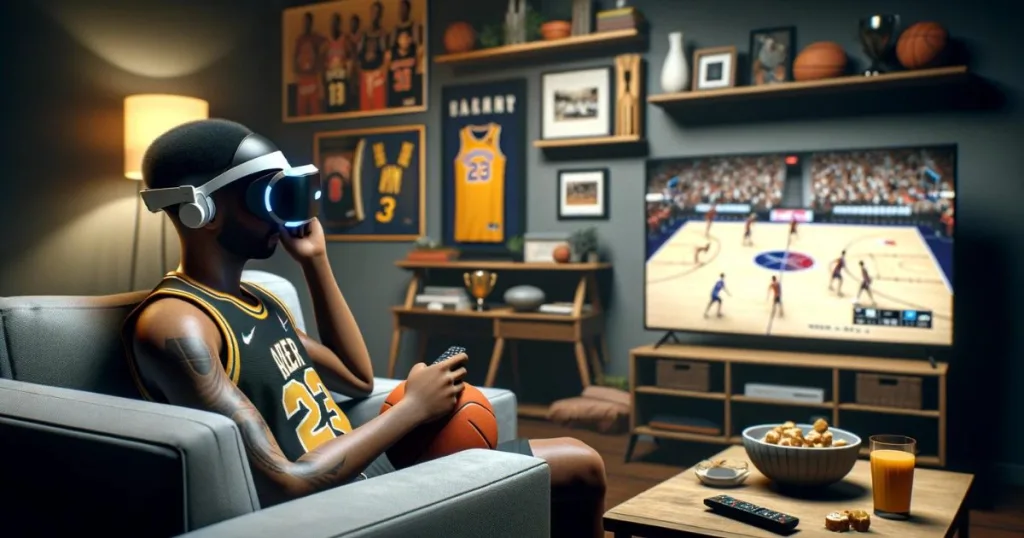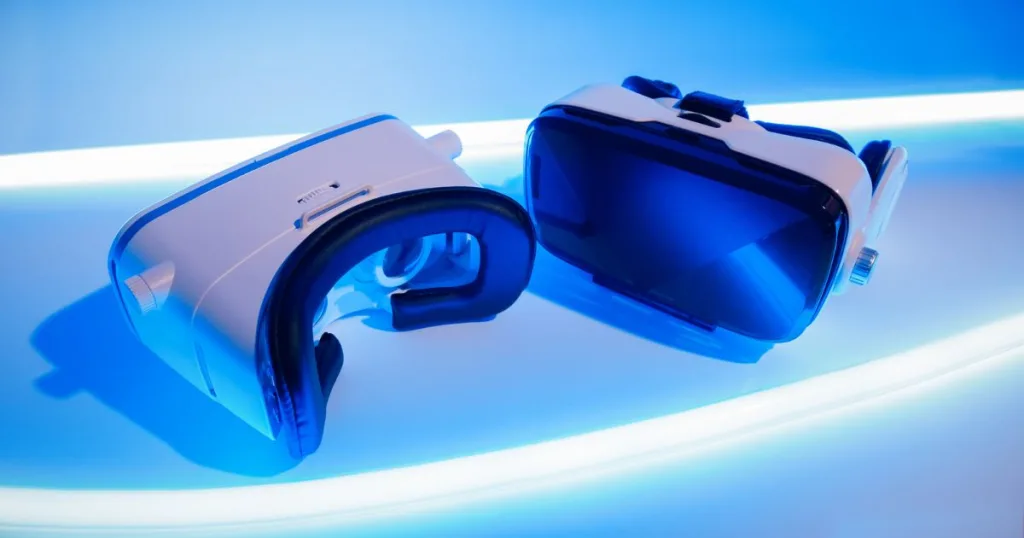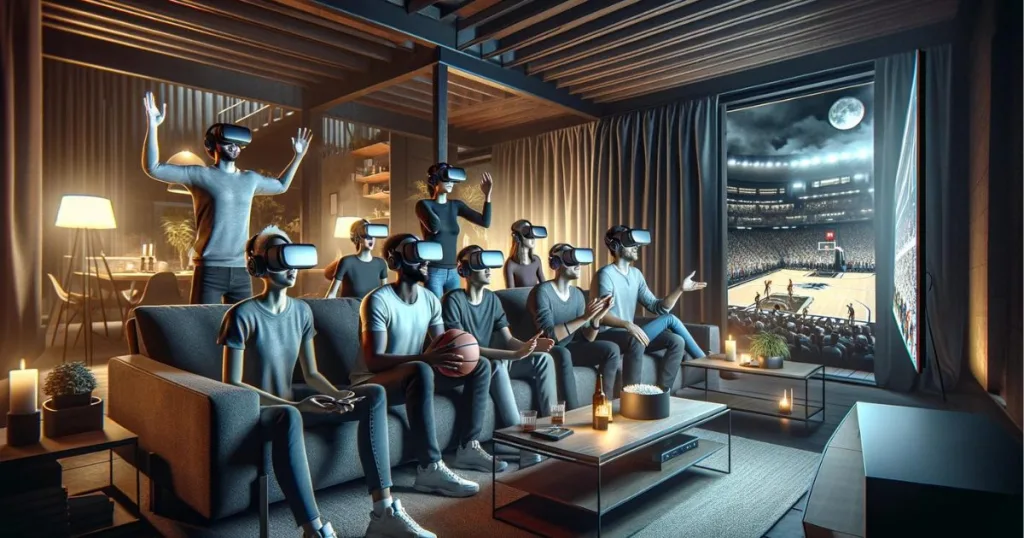Last Updated on: 2nd March 2024, 01:56 am

Imagine sinking a game-winning three-pointer from the comfort of your living room, feeling the crowd’s roar erupt around you.
Or, picture yourself stepping onto the virtual court alongside your favorite stars, learning plays, and perfecting your jump shot under their expert guidance.
This isn’t science fiction; it’s the reality of basketball transformed by cutting-edge virtual and augmented reality (VR/AR) technology.
Gone are the days of passively watching the game from afar. VR/AR is ushering in a new era of immersive fan experiences, blurring the lines between spectator and participant. From virtual courtside seats that put you right in the heart of the action to interactive training sessions that let you hone your skills like the pros, VR/AR fundamentally changes how we experience basketball.
But this revolution goes beyond mere entertainment. VR/AR also holds the potential to democratize the game, making it accessible to fans with disabilities and offering unprecedented insights and training opportunities for athletes of all levels. As the technology continues to evolve, the possibilities seem limitless.
So, buckle up and prepare to take your fandom to the next level.
Just look at the rise in VR headset sales!
VR Headset Sales Trends (2016-2023)
- 2016-2018: This period marked the early adoption phase of VR technology, with significant interest driven by the release of high-profile VR headsets like the Oculus Rift, HTC Vive, and PlayStation VR. Sales were initially modest but grew as the technology improved and prices gradually decreased.
- 2019: Saw a notable increase in VR headset sales, partly due to the release of the Oculus Quest, which offered a high-quality standalone VR experience without needing a powerful PC or console. This period also saw increased content availability, which helped drive sales.
- 2020: The COVID-19 pandemic had a mixed impact on VR headset sales. On the one hand, supply chain disruptions and economic uncertainty posed challenges. On the other hand, lockdowns and the increased interest in home entertainment solutions led to a surge in demand for VR headsets, particularly for gaming and virtual social interactions.
- 2021: Continued growth in VR headset sales was observed, fueled by the ongoing demand for home entertainment and the introduction of new models, such as the Oculus Quest 2 (later rebranded as Meta Quest 2). The Quest 2, in particular, was praised for its improved performance, lower price point, and ease of use, contributing significantly to the mainstream adoption of VR.
- 2022-2023: The trend towards increased adoption of VR technology likely continued, driven by further advancements in hardware, a growing library of VR content, and broader applications of VR beyond
From Passive Watching to Immersive Participation
Remember the days of glued eyes on the screen, anxiously hoping for a last-second shot? While the thrill of the live game remains unmatched, VR/AR offers a whole new dimension of engagement, catapulting you from the couch to the heart of the action.

TNT and FOX have begun adopting VR to enhance the fan experience for major sporting events, allowing viewers to virtually step into games and analyze plays from perspectives previously only available to players.
Let’s explore some of the groundbreaking experiences currently redefining what it means to be a basketball fan:
Virtual Courtside Seats: Where Every Seat is the Best Seat in the House
Imagine trading your grainy TV screen for a 360-degree view of the court, feeling the bass of the dunk vibrate through your chest, and even high-fiving your virtual neighbors as your team scores.
That’s the magic of virtual courtside seats. VR headsets transport you right next to the action, immersing you in the sights, sounds, and even the crowd’s energy like never before.
It’s helped create a fanbase that will never actually be in the same room as a game, but loves it as much as if they were watching it live. Those same fans can be served by VR. – https://www.smithsonianmag.com/smart-news/why-basketball-perfect-sport-vr-180961453/
No more blocked views or distant cheers – you’re part of the game, experiencing it with an intensity that traditional viewing can’t match.
Learn Like the Pros, Play Like a Star With Interactive Training Sessions
Have you ever dreamed of learning plays alongside LeBron James or perfecting your shooting form with Steph Curry? With VR training sessions, this fantasy becomes a reality.

Step onto a virtual court designed by professional coaches, complete drills to hone specific skills, and receive real-time feedback from AI-powered avatars.
Whether you’re a seasoned player or just starting, VR training offers a personalized, interactive way to improve your game and learn from the best.
Unveiling the Hidden World of Basketball
The excitement doesn’t stop with the final buzzer. VR/AR unlocks a treasure trove of exclusive experiences that take you behind the scenes and into the heart of the basketball world.
Virtually explore team locker rooms, attend press conferences, or join players on the road as they travel to away games.
This unprecedented access grants a deeper understanding and appreciation for the dedication, camaraderie, and behind-the-scenes realities that shape the game you love.
From Headsets to Software, Building the VR/AR Dream
The immersive experiences we just explored wouldn’t be possible without incredible VR/AR technology advances.
Let’s take a peek under the hood and see how hardware, software, and seamless integration are making the basketball fan experience revolution a reality:
VR/AR Hardware: Your Gateway to the Virtual Court
First things first, you need the tools to enter the virtual world. Headsets like the Apple Vision Pro, Oculus Quest 2 and PlayStation VR provide stunning visuals and immersive sound, transporting you right into the action.
Sensors track your movements, adding another layer of realism as you interact with virtual objects and environments. Haptic feedback suits even push the boundaries further, allowing you to feel the impact of a block or the swish of a perfect shot.

Of course, accessibility is crucial, and developers are constantly working on innovative solutions to ensure everyone can enjoy the VR/AR experience.
Software Platforms: Where Magic Comes to Life
But headsets alone aren’t enough. The software platforms behind them are the architects, bringing the virtual world to life.
Powerful engines create stunning visuals and realistic physics, while user-friendly interfaces ensure anyone can easily navigate the experience.
Development tools empower creators to build diverse content, from interactive training drills to virtual tours of iconic arenas.
With data and analytics playing an increasingly important role, these platforms personalize the experience, tailoring content to your preferences and providing valuable insights to fans and the industry.
Stadium Integration and Mobile Apps: Seamless Connection, Enhanced Experience
VR/AR doesn’t exist in a vacuum. For a truly immersive experience, it needs to integrate with the physical world seamlessly. That’s where stadium integration and mobile apps come in.
Imagine walking into an arena and using your phone to access exclusive VR experiences tailored to your seat location. Or picture virtual overlays on your phone screen, enhancing live viewing with real-time stats and player information.
This seamless connection between the physical and virtual realms is crucial for maximizing engagement and creating a truly unified fan experience.

The Impact of VR/AR on Basketball – From Fans to the Future
The transformative power of VR/AR in basketball doesn’t stop at entertainment. This technology is having a profound impact on various aspects of the game, leaving ripples across the entire ecosystem:
Transforming Fan Engagement and Revenue
VR/AR isn’t just a fad; it’s a game-changer for fan engagement. Studies show increased attendance, sponsorship opportunities, and merchandise sales tied to VR/AR implementation.
Fans are more invested, passionate, and willing to spend when they feel actively involved in the experience.
Affordability and accessibility remain crucial considerations for ensuring inclusivity and equitable access to this new wave of engagement.
Expanding Accessibility for All Fans
The beauty of VR/AR lies in its potential to overcome physical limitations. Fans with disabilities who might face challenges attending live games can now experience the thrill of courtside seats or participate in interactive training sessions from their homes.
This inclusivity expands the fan base and fosters a deeper connection to the sport, fostering a sense of community and belonging. As VR/AR technology continues to evolve, affordability and accessibility will be crucial factors in ensuring this technology democratizes the game for all.
The Power of Data and Personalization
Data is the fuel that drives personalization in the VR/AR realm. Platforms can tailor experiences to individual needs and desires by analyzing preferences, performance, and engagement.
Imagine training sessions focusing on your weaknesses or virtual courtside seats adjusted to your favorite player’s perspective. This personalization enhances the experience and provides valuable insights to athletes, coaches, and organizations, helping them understand fans and tailor their offerings accordingly.
However, ethical considerations regarding data collection and usage require careful attention to ensure privacy and responsible management of personal information.
Where Will VR/AR Take Us In The Future?
The future of VR/AR in basketball is brimming with possibilities. Mixed reality, where virtual elements seamlessly blend with the physical world, could create even more immersive experiences.

Imagine practicing plays against holographic opponents or interacting with virtual coaches in real time. Social VR might enable fans to share experiences and cheer in virtual arenas, fostering a stronger community.
AI-powered experiences could personalize every interaction, offering tailored training programs and real-time feedback, pushing the boundaries of entertainment and performance enhancement.
As VR/AR continues to evolve, its impact on basketball is only beginning to unfold. From revolutionizing fan engagement to democratizing access and even shaping the future of training and performance, this technology holds the potential to fundamentally transform the way we experience and engage with the game we love.
It’s an exciting time to be a basketball fan, and the future driven by VR/AR promises to be even more immersive, interactive, and personally meaningful than ever before.
